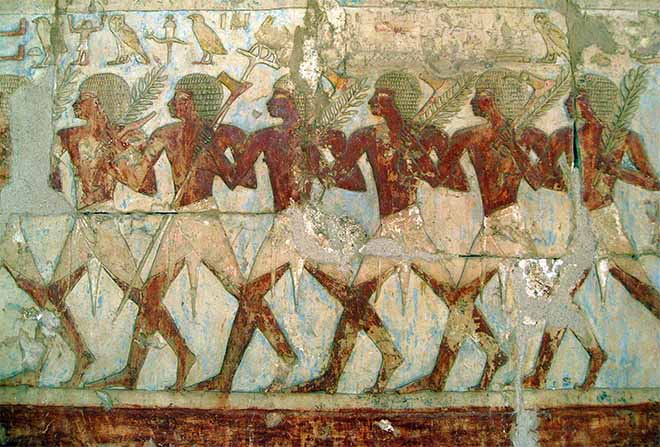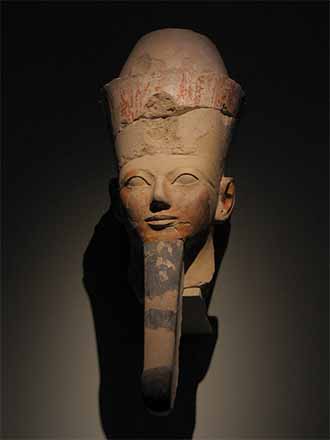Legendary Land of Punt And The Temple of Queen Hatshepsut
A Mythical Country of Ancient Egypt ?

If there is one thing we can say about ancient Egypt, it is that they liked to build monuments. Pyramids, temples, tombs, obelisks and statues dot the landscape of present-day Egypt. Not content with having built monuments, the Egyptians liked to decorate them: inscriptions, bas-reliefs and, where they survived, innumerable paintings and drawings. With documents written on papyrus (rolls of Egyptian paper) and clay tablets, they left us a remarkable insight into a culture that lasted 3,000 years, from around 3,000 BC up until the Roman era and the birth of Christ. In addition to informing us about themselves and their exploits, Egyptians also left us a wealth of information on the peoples who occupied the surrounding territories. Most of them are well known, but one of them remains an enigma. There are a number of references to trade missions to a place Egyptians called the Land of Punt. They considered it a place of great beauty, a sort of old Shangri-La, where life was easy, or at least, much easier than it was in Egypt. But what they don't tell us is where this land was actually located.
Unknown lands
Egyptians are the only ones to have spoken of the Land of Punt, which means either that it was not well connected with the outside world, or that it was known elsewhere by another name. In Egypt, the Land of Punt is mentioned throughout history and it is almost always described in a positive way, generally in relation to the abundance of the resources which are available there and the good commercial relations between the two countries. Unlike almost all other countries known to Egyptians, who were still at war with a people, there is no record of wars or invasions between the two countries. The Land of Punt seems to have been considered as completely peaceful and harmonious, while being at the origin of many highly coveted commercial products.
The reliefs of Queen Hatshepsut Temple at Deir el-Bahari

The most complete account of the Land of Punt comes from the temple of Queen Hatshepsut at Deir el-Bahari, on the west bank of the Nile, in Upper Egypt, near the Valley of the Kings. On the second level of the three terraces making up the building, vast reliefs depict a commercial mission in the Land of Punt. These bas-reliefs are the only known ones that show the individuals and landscapes of a country other than Egypt, which gives an indication of the importance that Egyptians, who were otherwise very egocentric, attached to the Land of Punt.
Queen Hatshepsut facts

Hatshepsut became queen on the death of her husband, Thutmose II. She reigned for 22 years, from 1479 to 1458 BC. Belonging to the 18th dynasty, she was a direct ancestor of Tutankhamun, who ascended to the throne about a century later. Although unusual in Egypt, the coronation of a queen was not without precedent, however. The reign of Hatshepsut coincides with a period of prosperity and stability, which is reflected in the amount of construction work carried out during her life, including the mortuary temple which would allow her to ensure that she would not be forgotten even after her death.
Trade missions
The number of funerary temple bas-reliefs depicting the Land of Punt demonstrates that Hatshepsut viewed the trade mission as one of her greatest achievements as a queen, and perhaps shows the restoration of commercial ties after a long period of time of inactivity. Hatshepsut sent 5 ships to the Land of Punt, where they exchanged, among other things, gold, ivory, wild animals and various aromatic resins, in particular myrrh. The bas-reliefs show the king of Punt, named Parahu, and his wife, Ati, who is not presented in her most flattering light. She is a fairly strong lady who travels on a donkey. In the scenes of village life, the inhabitants of Punt are depicted as being tall and handsome, the men having, unlike Egyptians, a short beard and long hair. They live in conical houses built on stilts, and raise small horned cattle. There are many representations of wild animals, including giraffes, rhinos, hippos and leopards. These, as well as the scenes showing fish from the Red Sea, suggest that the Land of Punt was located on the Red Sea coast of Africa, in the region of what is now Eritrea, Djibouti and Somalia. This hypothesis is supported by the commercial goods acquired during the Egyptian mission, which were all available in this part of Africa. According to another hypothesis, the Land of Punt is located further inland, along the banks of the Upper Nile in what is today South Sudan. A fascinating body of evidence seems to converge on this theory. The Dinka, who live in the region today, are tall and, during the rainy season, still build conical houses on stilts. But in addition to a lag of 3,500 years, the fish represented on the bas-reliefs are saltwater species from the Red Sea and not freshwater fish found in the Nile.
Yemen ?
The bas-reliefs of the temple of Hatshepsut may not provide enough evidence to locate the Land of Punt accurately, but they certainly point to an African location located somewhere in the south of Egypt. However, not everyone accepts this interpretation. The French Egyptologist Dimitri Meeks maintains that if all the sources of information on the Land of Punt are taken into account, and not only the bas-reliefs, the hypothesis according to which the Land of Punt is in Africa suffers from serious doubts. He believes the most likely location is on the Red Sea coast of the Arabian Peninsula, particularly the southern end of it, in what is now Yemen. In the texts referring to the Land of Punt and drawn from different periods of Egyptian history, the location, although not specified with precision, seems to be in the east of Egypt, rather than towards the south, and can be reached by land through the deserts of Sinai and the Negev, as well as across the Red Sea by boat.
The list of commercial goods donated by the Egyptians points, in some respects, towards the Arabian Peninsula. The Egyptians were particularly keen to acquire aromatic resins, which they used in religious rituals, as well as myrrh, which is found in Africa and Arabia. They also traded other varieties, such as pistachio resin, which is only found in the Middle East. The presence of African fauna on the bas-reliefs of the temple of Hatshepsut could, according to Meeks, be the result of exchanges by the Puntites, who would have acted as intermediaries by supplying the Egyptians with animals from elsewhere. One could of course make the same argument for the presence of Arabian resins in Africa, so, in the absence of any consistent evidence, it is difficult to know for sure.
A mythical land ?
The Egyptians perhaps considered the Land of Punt as a mythical land of abundance and not as a specific place, which varied thus at different times and according to the commercial products which they received. It is therefore pointless to locate it precisely. For the moment, we completely ignore the true identity of the Land of Punt.









































































































































































































































































































































